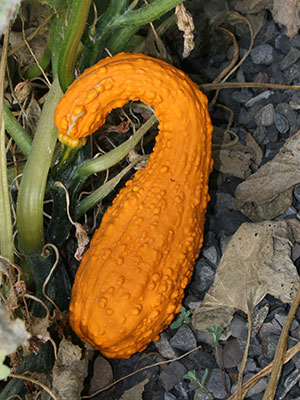Ornamental Gourds

Ornamental gourds are part of the Cucurbitaceae family and related to edible squashes and pumpkins, but are grown to full maturity and then dried to use for decoration. They’re readily available in grocery stores and farmers markets, and several types can be successfully grown in North Florida.
Most ornamental gourds can be grown attractively on trellises, arbors, and fences. This saves space and prevents fruit rot.
In North and Central Florida, plant as soon as the danger of killing frost is past. Gardeners in South Florida can plant seeds in September through March. Hills (1 to 2 seeds each) may be spaced 12 to 24 inches apart at the base of the trellis. If planted in an open garden, allow 4 feet between vines in the row and 4 feet between rows. Plant seed 1 to 2 inches deep.
Unlike edible squash, which are picked in an immature stage, gourds should be allowed to mature and dry on the vine if possible. Use sharp shears to harvest the gourds; never twist them from the plant. Once harvested, the fruits may be washed in warm soapy water then rinsed and dried. A month or two of drying and curing in a dry, warm, airy room may be needed. Sunlight may fade a gourd’s color during drying.
These fruits may be used with natural colors and shapes unchanged, or they may be sanded and painted in creative colors and designs. Gourds can also be used for practical purposes, such as hanging baskets, vases, fruit bowls, dippers, birdhouses, and toys.
UF/IFAS Publications
- Drying and Preserving Plant Materials for Decorative Uses
- Gourd, Ornamental — Lagenaria spp., Cucurbita spp., and Luffa spp.
